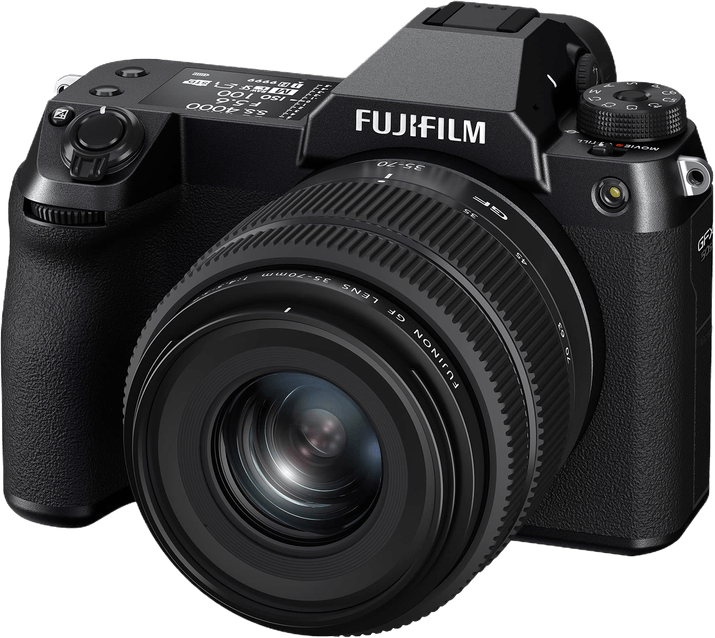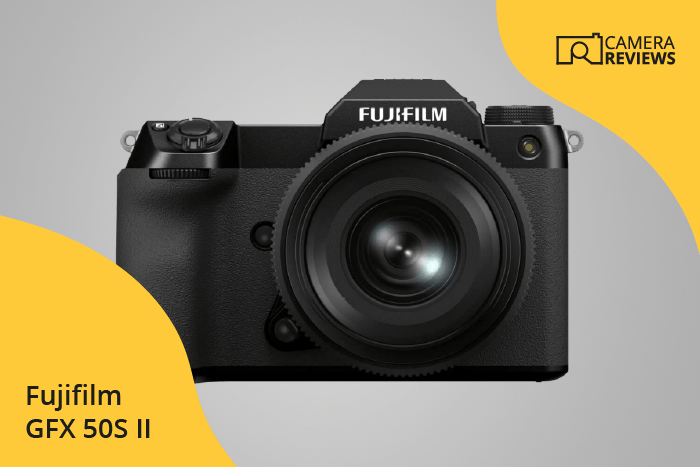Fujifilm GFX 50S II Specs and Scores

The Fujifilm GFX 50S II boasts a solid score of 79 out of 100. Announced on September 2, 2021, this mirrorless camera is packed with impressive specifications. Priced at $3,999, the GFX 50S II measures 150 x 104 x 87mm and weighs 900g (1.98lbs). These features make it a competitive choice in today’s market.
Considering its specs and release year, the Fujifilm GFX 50S II stands strong among other cameras. Its compact size and lightweight design make it a versatile option for photographers seeking quality and convenience.
Fujifilm GFX 50S II Overview and Optics
The optics of the Fujifilm GFX 50S II receive a score of 77/100. With 51 megapixels, a shooting speed of 3 frames per second, and a medium format CMOS sensor, this camera offers impressive image quality. The X-Processor 4 allows for efficient processing and the Fujifilm G lens mount provides compatibility with a range of high-quality lenses.
In the market today, the GFX 50S II stands strong due to its medium format sensor size, which captures more detail and provides better dynamic range than the typical full-frame sensors. The 4:3 aspect ratio is beneficial for various photography styles, such as landscape and portrait. Additionally, the built-in image stabilisation enhances the camera’s performance in low-light conditions and allows for sharper images.
The Fujifilm GFX 50S II offers a competitive optics performance, making it a solid choice for photographers seeking high-resolution images and a versatile camera system.
Fujifilm GFX 50S II Video Performance
The Fujifilm GFX 50S II received a video score of 57 out of 100. This camera offers Full HD video resolution with maximum dimensions of 1920 x 1080 and a frame rate of 30fps. It also includes built-in time-lapse functionality.
In today’s market, the video capabilities of the GFX 50S II are not exceptional. Many modern cameras offer 4K video resolution or higher, with faster frame rates for smoother playback. The Full HD resolution and 30fps frame rate may limit the camera’s appeal to videographers seeking advanced video features.
While the Fujifilm GFX 50S II has impressive specifications in other areas, its video capabilities are not its strongest selling point. The camera is better suited for photographers who prioritize still image quality and do not require cutting-edge video features.
Fujifilm GFX 50S II Features and Benefits
The Fujifilm GFX 50S II boasts a feature score of 87 out of 100, showcasing its competitive edge in today’s market. With a 3.2-inch touchscreen and a screen resolution of 2,360,000 dots, the camera ensures user-friendly navigation and clear image previews. The flip screen adds versatility, catering to various shooting angles and creative compositions.
Despite lacking GPS functionality, the GFX 50S II compensates with both Wi-Fi and Bluetooth capabilities, making it easy to transfer files and remotely control the camera. These features contribute to the camera’s high score and make it a strong contender in the current market. The Fujifilm GFX 50S II is a reliable choice for photographers seeking a feature-rich camera that delivers both convenience and quality.
Fujifilm GFX 50S II Storage and Battery
The Fujifilm GFX 50S II storage and battery score is 71/100, showcasing its performance in this category. The camera is equipped with two memory card slots that accept SD, SDHC, and SDXC cards, all of which are UHS-II compatible. This compatibility provides faster transfer speeds, an important feature in today’s market.
The battery life of the GFX 50S II allows for 440 shots per charge, using the NP-W235 battery type. This camera also offers USB charging, providing flexibility and convenience for users. While the battery life is sufficient for most photography sessions, it may require additional batteries for extended use.
Taking into account the storage and battery specifications, the Fujifilm GFX 50S II performs well in the current market. With its dual memory card slots and USB charging capabilities, it offers both convenience and functionality for users.
Fujifilm GFX 50S II Alternatives
Do you want to know how the Fujifilm GFX 50S II compares to its competitors? Have a look at the most popular comparisons for this camera below:
- Fujifilm GFX 50S II vs Sony a1
- Fujifilm GFX 50S II vs Olympus OM-D E-M10 Mark IV
- Fujifilm GFX 50S II vs GFX100S
- Fujifilm GFX 50S II vs X-H2
- Fujifilm GFX 50S II vs Sony a7 IV
- Canon EOS R6 Mark II vs Fujifilm GFX 50S II
Fujifilm GFX 50S II FAQ
Does the Fujifilm GFX 50S II Have Built-in Image Stabilization?
Yes, the Fujifilm GFX 50S II features a 5-axis in-body image stabilization system, which helps to reduce camera shake and improve image sharpness in various shooting conditions.
Does the Fujifilm GFX 50S II Support 4K Video Recording?
No, the Fujifilm GFX 50S II does not support 4K video recording. The maximum video resolution it offers is Full HD (1920×1080) at 30fps.
What Size Sensor Does The Fujifilm GFX 50S II Have?
The Fujifilm GFX 50S II is equipped with a medium format 51.4-megapixel CMOS sensor, which provides exceptional image quality and detail.
Does the Fujifilm GFX 50S II Have a Dual Memory Card Slot?
Yes, the Fujifilm GFX 50S II features two SD card slots, allowing for greater flexibility and backup options when shooting.
Does the Fujifilm GFX 50S II Have a Touch Screen?
Yes, the Fujifilm GFX 50S II has a 3.2-inch tilting touch screen LCD, which allows for easy navigation and control of the camera’s features.
Does the Fujifilm GFX 50S II Have Wi-Fi and Bluetooth?
Yes, the Fujifilm GFX 50S II includes both Wi-Fi and Bluetooth connectivity, enabling remote control and image transfer to compatible devices.
Does the Fujifilm GFX 50S II Have GPS?
No, the Fujifilm GFX 50S II does not have built-in GPS. However, location data can be added to images using a compatible smartphone via the Fujifilm Camera Remote app.
Is the Fujifilm GFX 50S II Weather Sealed?
Yes, the Fujifilm GFX 50S II is weather-sealed with 60 points of weather sealing, making it resistant to dust, moisture, and low temperatures for reliable performance in challenging conditions.
Does the Fujifilm GFX 50S II Have a Built-in Flash?
No, the Fujifilm GFX 50S II does not have a built-in flash. However, it does have a hot shoe for attaching an external flash if needed.

